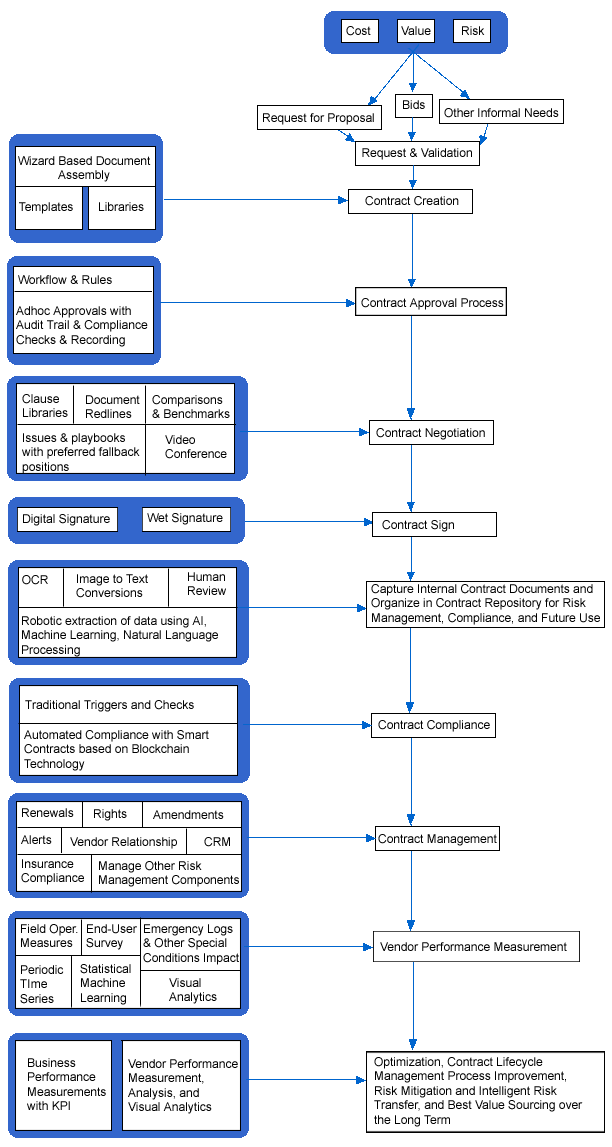

Contract Management
- Request - The lifecycle of any contract typically begins with a request from the business, describing what they need for some project or deal. The challenge is to make the request process simple and intuitive, collect the right information to guide people quickly to the appropriate paperwork, whether it’s a complex purchase order or a simple NDA. With a fast and easy request process, the risk of rogue deals — and risky terms — is dramatically reduced.
- Create - Creating new contracts, amendments, purchase orders, and more, requires drafting and/or using one or more documents and clauses based on approved templates in contract management libraries. Contract professionals and other experts deal with creating and managing contracts for complex or risky deals. For simpler contracts, the business process may prefer a fast, self-service option for creating their own documents. And, in many scenarios, automated wizard-based document assembly delivers better quality documents much faster than manually drafting the document in Word.
- Approve - Most enterprises have rules about who must approve each contract depending on risk, value, and other factors. These rules are typically defined in a delegation of authority instruction set and shared with everyone who needs to know. In some cases, the rules may be embedded into a workflow process, which controls the release of documents while an approval task is pending. In other cases, ad hoc approval tasks can be recorded for audit trail and compliance purposes, but with fewer controls and more flexibility for individual users.
- Negotiate - Negotiating the terms of larger deals is a common practice to balance the contractual allocation of risk against the value and the impact of the deal to the organization. Negotiations may cover commercial, legal, and financial terms, and may involve many different parts of the organization and people on either side of the contract. Throughout the process, negotiators and contract managers may leverage a variety of tools, including clause libraries, playbooks with preferred and fallback positions, document redlines with comments and comparisons, and issue/complexity lists. Transparency and audit trail can be maintained by keeping history and version documentation.
- Sign - Signature from each party in the final agreement is required to close any deal. This may be achieved by a wet signature on a paper document, or by a digital signature on an electronic document. When all signatures are complete, the final executed contract is exchanged and retained by each party. This can be in the form of a hard copy, soft copy or both.
- Capture - For a complete insight into a contract portfolio and contractual risk, it is essential to capture all relevant documents during the process in a central system, and to capture structured, machine-readable data from those documents. This may include natural language processing based automated “discovery” of contractual documents scattered across internal systems, automatic OCR conversion and conversion of imaged documents into text, computer automated extraction of data using data science, machine learning, and AI. It may also need human review and curation for contractual process quality assurance in high-complexity contracts.
- Comply - Complying with the various contract obligations and commitments is the most immediate, and resource intensive challenge for any active contract. Failure to monitor and satisfy performance, payment, and reporting, legal requirements or credit support obligation will likely trigger a contractual breach, with the risk of exposure to substantial liabilities and losses. Contractual and regulatory compliance failures can cause serious damage to an organizations risk mitigation infrastructure and reputation.
- Manage - Beyond compliance, an enterprise must manage the rights/obligations, renewals, amendments, reissuance and ongoing relationships defined throughout its contract portfolio. Automated tracking based triggers and alerts can eliminate the high cost of missing an important right or contract renewal. For effective management of customer and vendor relationships, contractual data must sometimes be linked to performance data and external reference databases.
- Vendor and/or source provider performance -
It is essential to measure the performance of the vendor over the time of the contractual lifecycle. In essence, it is the first step towards optimal best value sourcing. Business performance can be measured with Key Performance Indicators (KPIs) or Vendor Performance Indicators (VPIs).
VPIs consist of:
- Operational field management surveys
- End user perception studies
- Emergency/special situation logs and feedback mechanisms. - Visual Analytics and statistical learning - Use of density plots, visual analytics, and statistical learning based reports provide the indication of best value sourcing and management. It also provides a glimpse of hidden opportunities where a best value sourcing and CLM system can focus to improve productivity, reduce cost, and risk.
- Optimize - With more data, intelligent analysis and improved insight into contractual terms and performance, a business can optimize its portfolio for better value, and reduced risk outcomes. For strategic high performance contracts, the goal is a continuous feedback loop between the contract portfolio and business performance. Over time the business goal is to attain a better value with lower risk and cost.

